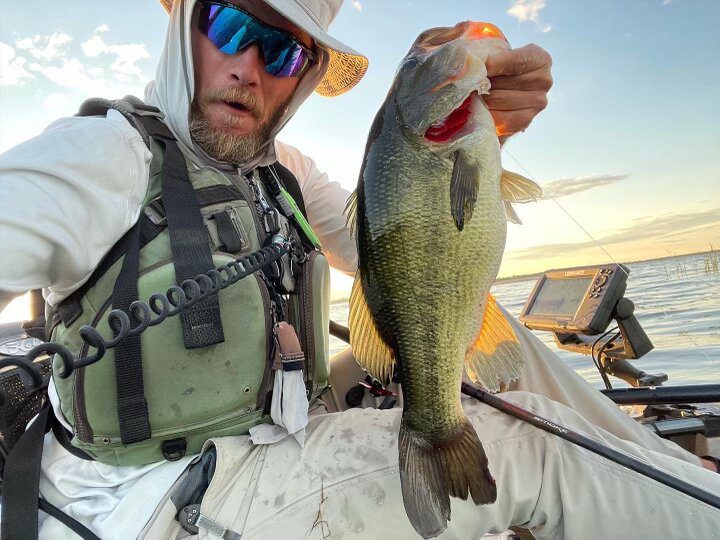Don’t Be Afraid to Break the ‘Rules’
[print_link]
Bass fishing has lots of rules. At least that’s what I thought when I fell in love with the sport. This was still a few years before the internet, so it was more difficult to get current information. I would go to the local library and read fishing articles from every outdoor magazine they carried. I read and reread every dusty, old fishing book. I practically memorized an old VHS tape of Paul Elias, filmed not long after his Bassmaster Classic win. While learning everything I could about bass fishing, I made a critical mistake. I began treating the information like it was a set of rules. The authors, guides, and tournament anglers were the best at their craft, and I wanted to be like them. They were teaching me the “right way” to fish, so their way became the only way. The norms became rules. This was a crippling mindset for a new angler because it restrictedcreativity and experimentation. Don’t believe me? Here are some examples that illustrate what not to do.
On one afternoon, a buddy and I were fishing a small pond we had never visited before. We were both using four-inch, curly tail plastic worms. I’d learned that worms should be dragged or hopped along the bottom, so that’s how I fished mine. My buddy was swimming his. Oddly, he caught three fish, and I didn’t catch any. It had to be a fluke, beginner’s luck maybe. After all, he was doing it wrong. Fast forward several years, and I’m fishing with my younger brother. He likes usinga Texas-rigged worm, and he’s pretty good at it. A couple of times during the day, I noticed that his worm was kinked. The plastic in the head had torn, and it was allowing the worm to slide down the shank. This is generally not good. It causes the lure to spiral unnaturally as it falls, and it twists the line. But my brother didn’t care. He wouldn’t rerig, even after I pointed it out…multiple times. “This one’s still good,” he said. He then proceeded to catch several more fish with the twisted worm. I just shook my head. Another fluke. Or maybe his fish were just stupid.
It wasn’t until years later that I learned from these experiences. There is no “right way” to fish. The right lure or technique is the one that works today. Successful bass anglers are constantly experimenting. My buddy had the right idea at the farm pond. We had never heard of swimming a worm. But he had an open mind and tried different retrieves until he found one that worked. Then he duplicated that retrieve. I was hardheaded and kept fishing the “right” way. My reward was no fish. Even worse, I didn’t learn from the experience. I could’ve added a new weapon to the arsenal that day. Instead, it was years later when I learned that swimming a worm is actually a killer technique, especially in lakes with grass. It was one of the “right” ways after all. As for my brother, I should’ve been more inquisitive and paid attention to how he was manipulating theunorthodox lure. What he did was working. I should have tried to understand why, rather than being dismissive.
My point is that experimentation and adjustments are keysto successful bass fishing. That isn’t to criticize folks who have a favorite lure and like to fish it the same way. Early on, I fished a soft plastic finesse worm almost exclusively. You can still catch plenty of fish with this approach, but there will be some days when your technique – whatever it is – just doesn’t work. That’s when it pays to have some other options. Versatility is a common trait among the best fishermen, and the only way to become versatile is to try new things. This could be fishing a different body of water. If your favorite lake is deep and clear, try fishing a lake with shallow dirty water. If you’re a river rat, try fishing a reservoir. Work to learn a new technique, maybe one you read about in Bassmaster. Along the same lines, experiment with your retrieve speed and cadence. Try different sinker sizes to get different fall rates. Throw a bigger or smaller bait than you typically would. Maybe try an oddball color. Through trial and error, you will learn what works and what doesn’t. You might even stumble across the next big trend in our sport.

Speaking of trends, the Chatterbait and wacky-riggedSenko are arguably the two biggest lure innovations in my lifetime. The Whopper Plopper is another great bait that became popular in recent years. I remember when these baits first hit the market, how effective they were, and how slow I was to jump on the bandwagon. I still had the wrong mindset. When I was learning at the library, these lures didn’t exist. They weren’t among the tried-and-true fish catchers, so I was hesitant to try them, especially the wacky rig. It broke the rules, and it looked silly. “They’re fishing it wrong,” I thought. Turns out I was the one who was wrong. Now vibrating jigs, soft stickbaits, and ploppers are staples in nearly everyone’s tackle box, including mine. Think of how many fish have been caught because those innovators were thinking outside the box.
So, if you are just starting out in the sport of bass fishing, keep an open mind and be creative. As you gain experience, stay humble. It’s hard to learn and improve if you think you already know everything. No matter how long you’ve been at it, there is always something that you can learn on the water.Experimentation will speed up the learning process and help you catch more fish. Don’t be afraid to buck conventional wisdomand break the rules.

